Balin
Description:
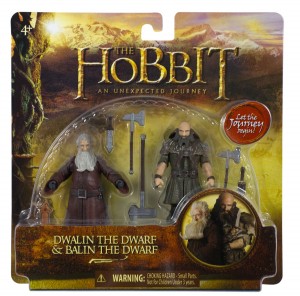 “Balin is a noble dwarf and one of the oldest members in the dwarf company. By nature wise and gentle, he had to get used to a military life, as he hovered constantly between life and death. As a close cousin of Thorin Oakenshield he is one of his closest and most trusted advisers. But deep in his heart the wisest and most faithful of the dwarves asks whether it is wise to try to reclaim the Lonely Mountain.”
“Balin is a noble dwarf and one of the oldest members in the dwarf company. By nature wise and gentle, he had to get used to a military life, as he hovered constantly between life and death. As a close cousin of Thorin Oakenshield he is one of his closest and most trusted advisers. But deep in his heart the wisest and most faithful of the dwarves asks whether it is wise to try to reclaim the Lonely Mountain.”
Analysis and speculation:
It is important to remember that, in The Hobbit, Balin was the first dwarf to gain respect for Bilbo when the hobbit snuck past Balin, who was on lookout duty, following the Company’s escape for the Misty Mountains. Later, he was the only dwarf to accompany the hobbit halfway down the secret passage to Smaug’s lair. In short, he is Bilbo’s strongest ally among the dwarves.
According to the filmmakers interpretation, Balin is the most sceptical of the Quest to reclaim the mountain. Furthermore, remember that in FotR, the fellowship discover Balin’s tomb in Moria (in the books, he left the Lonely Mountain some 50 years after the events in the Hobbit to establish a new colony in Moria). Also bear in mind that the film-makers want The Hobbit to lead directly into the LotR trilogy.
Now assuming the second film will end with the death of Smaug, the third film will centre on Thorin’s growing paranoia and selfishness, and his refusal to parley with the men of Laketown, which leads to the mountain being besieged. Thorin’s narrow-mindedness and intransigence leads to Bilbo giving the Arkenstone to the Elven-King and Bard. This of course leads to Thorin banishing Bilbo from the mountain.
Yet it is undoubtedly the case that some of the dwarves will themselves have doubts about Thorin’s short-sighted approach. Chief among these would be Balin. This is because a) he is being written as a sceptic of the Quest, but comes along out of loyalty, and b) because he holds Bilbo in high regard. Thus the filmmakers might be planning on Bilbo’s banishment causing a schism in the Company, with Balin (with perhaps Oin in tow) choosing to depart the mountain. Refusing to take sides in the coming conflict, they make their way to Moria instead.
Doing this would accomplish two things.
First, it would link up with the fact that the fellowship discover Balin’s tomb in Moria in FotR (doing this would of course constitute a break from the source material, as Tolkien states that Balin sets out for Moria some forty years after the events of the Hobbit, but such a break would be a relatively minor one).
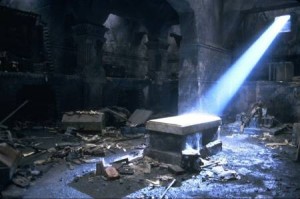 Second, Balin’s departure would heighten the drama and sense of a brewing tragedy around Thorin, who is described in the books as growing increasingly erratic and paranoid once he is de-facto King Under the Mountain following the death of the dragon. The loss of the confidence of his closest confidante would be a blow to Thorin, and play well dramatically.
Second, Balin’s departure would heighten the drama and sense of a brewing tragedy around Thorin, who is described in the books as growing increasingly erratic and paranoid once he is de-facto King Under the Mountain following the death of the dragon. The loss of the confidence of his closest confidante would be a blow to Thorin, and play well dramatically.
Bifur
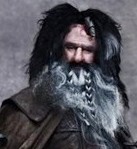 Description:
Description:
“Bifur is from the west, and carries the rusted remains of an orc ax in his forehead. Since this he cannot speak anymore, and sometimes he gets violent! He communicates only through grunts and hand signals. Unlike the other dwarves in the company he is not related to Thorin and also does not come from a noble lineage, but is a descendant of miners and blacksmiths — ordinary people with simple needs.”
Analysis and speculation:
When I first saw the axe in Bifur’s head in the production shots, I assumed it was from a mining incident. But it is likely that it will be explained through a dark comedic flashback of his role in some battle of other, perhaps the Battle of Azanulbizar. Perhaps he will be seen, in flashback, fighting with Thorin at the battle of Azanulbizar, perhaps involved in the incident which gave Thorin his unusual last name.
Radagast the Brown
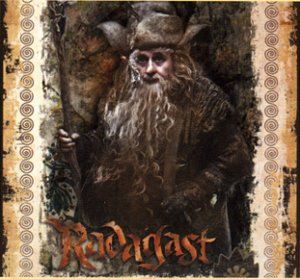 Description:
Description:
“Radagast is forgetful, seems to be slightly absent-minded and very eccentric. He talks preferably with animals than with people. As a magician colleague and friend of Gandalf the Grey, Radagast is one of the guardians of the great forests of Middle-earth. Often you meet him on his walks through the woods near his strange little house called Rhosgobel. The little wizard senses impending doom, because not everything is as it should be in the dark corners of Mirkwood.”
Analysis and speculation:
Radagast looks to be a significant character in this trilogy. It would be odd if he did not have a role in all three films. It is clear he is in the first film, as Gandalf will have to visit Rhosgobel on his way to Dol Guldur after he has left the Company at the Eaves of Mirkwood following the stay at Beorn’s house. In the second, he will probably join Gandalf in the assault on Dol Guldur itself. At the beginning of the third film, Radagast is likely to be the means by which Gandalf discovers Smaug is dead. Much as the palantir came to Gandalf at the beginning of RotK through the parley with Saruman, news of the dragon’s death (which portends the Battle of the Five Armies) will arrive while he, Radagast and Beorn are still in the ruins of Dol Guldur, in the aftermath of that battle. I would wager that a flock of birds will fly overhead, and from them Radagast, ‘the bird tamer’, will learn that the dragon in dead. Learning this, Gandalf spurs his horse north to the Lonely Mountain, but not before dispatching Radagast to inform the eagles of the Misty Mountains of the death of the dragon. This would explain how and why it is that the eagles themselves arrive at the Battle of the Five Armies.
Whether Radagast himself is at the Battle of the Five Armies (perhaps riding an eagle) is a mystery. However, I would wager that whatever happens, he will die in the third film. This would explain his absence in the LotR trilogy. While this could happen at the Battle of the Five Armies, it could also occur that Saruman, who manipulates Radagast in the books, kills him, perhaps when Radagast discovers that Saruman has a secret agenda. This would set in motion the descent into outright evil for Saruman, as evident in the Lord of the Rings trilogy. The death of Radagast, who is clearly portrayed as a warm, whimsically loveable character by Sylvester McCoy, would symbolise an end of innocence, a key theme of the Hobbit, and help transition to the darker, more urgent tone of the LotR trilogy.
Saruman the White
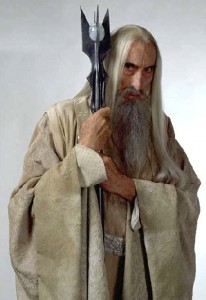 Description:
Description:
“The venerable and mighty Saruman belongs with four other wizards to the Guardians of Middle Earth that care for order and balance in the world. Especially Saruman arranges the fate of the free nations at his own discretion. As head of the White Council, he fears with growing unease that Gandalf the Grey and Thorin Oakenshield’s companions could mess up his careful calculations. Saruman is indeed very old and wise but gives in to his subliminal weakness and is greedy for power — a greed that ultimately produces the most deadly of all unions.”
Analysis and speculation:
First, it is interesting that five wizards are mentioned. This suggests there may be some explanation of the origins of the wizards in middle-earth, as the five are Gandalf the Grey, Saruman the White, Radagast the Brown and the two Blue Wizards who disappeared into the East long ago.
Second, the word used is ‘deadly’ in reference to his union with Sauron. This suggests he does something deadly in the Hobbit, which aligns with the idea that Radagast will die in the films. If this occurs, it will likely be a portend of things to come (in LotR) that adds a twist to the end of an otherwise happy end to ‘There and Back Again’, the third film, when Bilbo returns to Hobbiton.
Third, there is no suggestion that Saruman takes part in the battle of Dol Guldur. Given that Radagast is loyal to him as head of the Order, and trusting of his intentions, it is possible that Saruman sends Radagast to ‘represent’ him at Dol Guldur, but possibly with instructions to report back to him. It is on this return mission near the end of the trilogy, perhaps if Radagast has seen too much, when Saruman decides that he represents a risk to his carefully laid plans.
Elrond
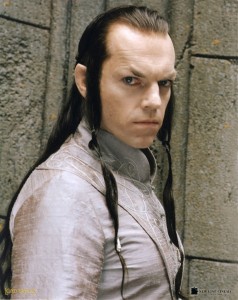 Description:
Description:
“Elrond is one of the oldest and wisest Elves who still live in Middle Earth. He is the Lord of Rivendell, the last homely house east of the Sea. Thorin & Co. stay only for a short time in Rivendell, but Elrond offers Bilbo and the dwarves lodging and food. The dwarves have a natural aversion to the Elves, but accept their help gladly. Elrond responded suspiciously to the dwarves’ project to reclaim their stolen treasure, but he gives those secret information that Gandalf and Thorin need to reach the Lonely Mountain.”
Analysis and speculation:
Elrond would appear to play the equivalent of a cameo role in the film, the Company’s host at Rivendell, and the device for necessary background exposition. There is no indication that he takes part in the Battle of Dol Guldur.
Galadriel
 Description:
Description:
“Galadriel is the oldest of the remaining elves in Middle-earth and has the gift of foresight. As the signs are increasing that doom threatens Middle-earth, she secretly supports Gandalf in his mission to track down the cause of evil. Galadriel knows of course that the Fellowship must succeed if the evil power shall not win the upper hand and the darkness dominates everything.”
Analysis and speculation:
Galadriel is perhaps the most enigmatic significant character in the Hobbit trilogy. While it is known that she attends the White Council in Rivendell (from the Cinema-con footage), and speaks with Gandalf in private in Rivendell (in the trailer), it does not seem that she actively takes part in the Battle of Dol Guldur herself. Yet she does apparently ‘secretly support’ Gandalf in his mission to ‘track down the cause of evil’. However, Philippa Boyens, part of the script writing team, has noted that Galadriel’s character was, at this time, the most powerful in Middle-earth, and thus she may well have some active role. Either way, it is hard to even speculate.


